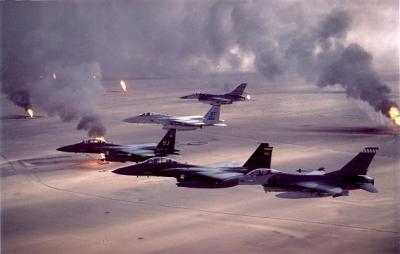Not only is war a big waste of time, money and most importantly life, it also has this nasty side effect of wreaking havoc on the local environment. Modern warfare tactics, as seen in the American war in Vietnam, the Rwandan and Congolese civil wars, and the current war in Iraq, have greatly increased our capacity to destroy the natural landscape and produce devastating environmental effects on the planet, according to Sarah DeWeerdt, author of “War and the Environment,” featured in the January/February 2008 issue of World Watch.
Wartime destruction of the natural landscape is nothing new, but the scope of destruction seen in more recent conflicts is unprecedented. “For one thing, there is the sheer firepower of current weapons technology, especially its shock-and-awe deployment by modern superpowers. The involvement of guerrilla groups in many recent wars draws that firepower toward the natural ecosystems-often circumscribed and endangered ones-where those groups take cover,” writes DeWeerdt.
The deliberate destruction of the environment as a military strategy, known as “ecocide,” is exemplified by the U.S. response to guerrilla warfare in Vietnam. In an effort to deprive the communist Viet Cong guerrillas of the dense cover they found in the hardwood forests and mangroves that fringed the Mekong Delta, the U.S. military sprayed 79 million liters of herbicides and defoliants (including Agent Orange) over about one-seventh of the land area of southern Vietnam. By some estimates, half of the mangroves and 14 percent of hardwood forests in southern Vietnam were destroyed during Operation Trail Dust, threatening biodiversity and severely altering vegetation.
Less deliberate, but still devastating, were the environmental effects that stemmed from the mass migration of refugees during the Rwandan genocide in 1994. Nearly 2 million Hutus fled Rwanda over the course of just a few weeks to refugee camps in Tanzania and the Democratic Republic of the Congo, making it the most massive population movement in history. Approximately 720,000 of these refugees settled in refugee camps on the fringes of Virunga National Park, the first United Nations World Heritage site declared endangered due to an armed conflict. The refugees stripped an estimated 35 square kilometers of forest for firewood and shelter-building materials. The dense forests also suffered as a result of the wide paths clear-cut by the Rwandan and Congolese
armies traveling through the park to reduce the threat of ambush by rebel groups.
The longterm ecological effects of the current war in Iraq remain to be seen. Looking to the effects of the recent Gulf War as a guide, scientists point to the physical damage of the desert, particularly the millimeter-thin layer of microorganisms that forms a crust on the topsoil, protecting it from erosion. Analysis of the area affected by the Gulf War has already shown an increase in sandstorms and dune formation in the region, and one study suggests that desert crusts might take thousands of years to fully recover from the movement of heavy vehicles.
“Warfare is likely to have the most severe, longest-lasting effects on protected areas that harbor endangered species, and slow-to-recover ecosystems such as deserts. Even in the most fragile environments, sometimes nature-and people-can surprise us,” writes DeWeerdt. “But turn and look in another direction and you are likely to see warfare’s enduring scars.”
